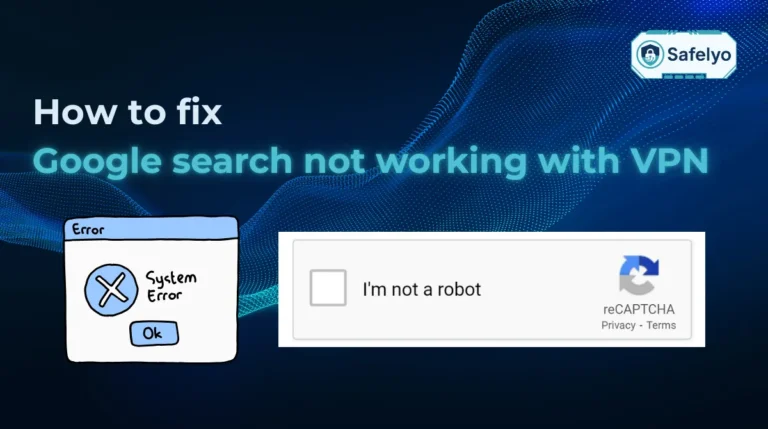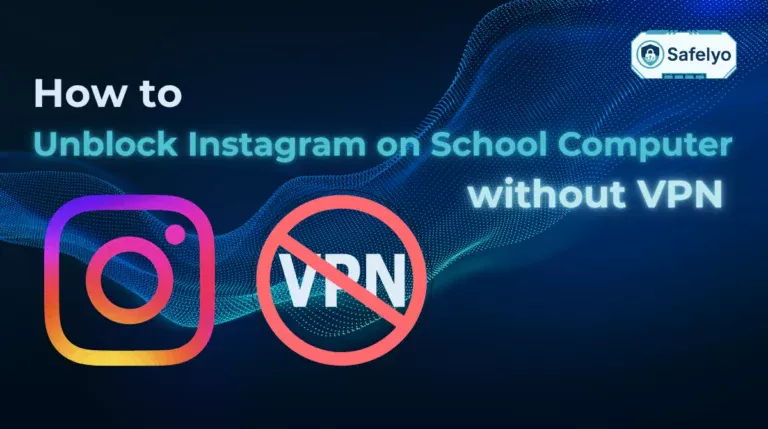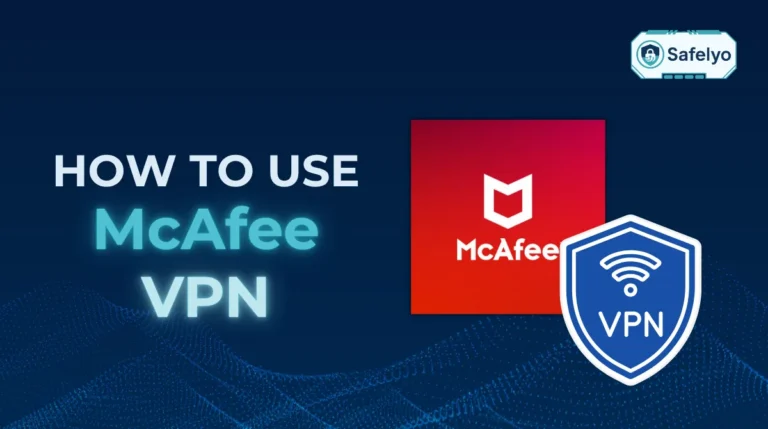It is unsettling to open the “Peers” tab in qBittorrent and see your real IP address exposed to strangers, or worse, to receive a warning letter from your ISP for P2P activity. Without protection, your download history is visible to anyone monitoring the network.
Fortunately, learning how to use a VPN with qBittorrent is the most effective way to anonymize your downloads and prevent speed throttling.
1. Quick start guide – How to use a VPN with qBittorrent in 5 simple steps
If you’re short on time and just want to start torrenting securely, follow these five steps. This method is beginner-friendly, fast, and works with most major VPN providers. Here’s how to set up qBittorrent with a VPN in just a few minutes:
1. Connect to your VPN provider
Launch your VPN app and connect to a server that supports P2P traffic. For best results, choose a nearby country that allows torrenting.
2. Enable the kill switch
In your VPN settings, turn on the kill switch feature. This ensures that if the VPN disconnects, your real IP won’t leak to peers.
3. Launch qBittorrent
Now open qBittorrent. Always launch it after the VPN is connected to ensure the correct network interface is used.
4. Add a torrent file
Download a test torrent like Ubuntu ISO or a Creative Commons movie. Add it to your client and watch the peers connect.
5. Verify your IP address
Use a torrent IP check tool like IPMagnet or a simple magnet links test to ensure only your VPN IP is visible.
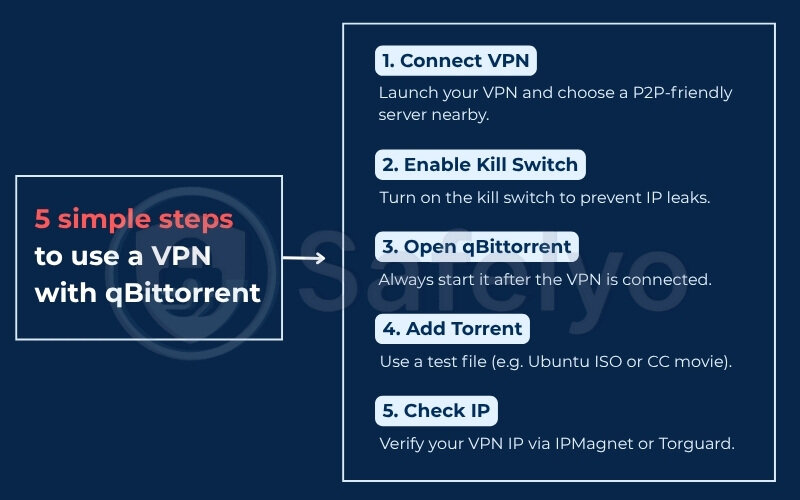
I recently timed myself running through this process on a fresh Windows laptop. From VPN install to torrent download, it took under 8 minutes – no advanced settings required.
Now that you’re protected, let’s explore how to choose the right VPN to keep your downloads fast and private.
2. How to choose the right VPN for qBittorrent
Before diving deep into how to use a VPN with qBittorrent, it’s crucial to understand that not all VPNs are built for torrenting or focused on online privacy. Some block peer-to-peer traffic altogether, while others log your activity or slow you down with throttled speeds. To use qBittorrent with a VPN effectively, you need to choose one designed for privacy protection, speed, and torrent support.
When I began comparing best VPNs for torrenting, I created a spreadsheet to track their key features, including kill switch reliability, P2P VPN server availability, price, and independent audit status. I was surprised when a lesser-known provider outperformed bigger names on real-world speed tests, customer support, and DNS leak protection.
2.1. Essential features: P2P servers, kill switch, no-logs, SOCKS5, etc.
Here’s a checklist of the features you should look for before committing:
| Feature | Why it matters |
| P2P servers | Ensure fast, unrestricted torrenting without blocking or throttling |
| Kill switch | Cuts the internet if the VPN drops to prevent real IP exposure |
| No-logs policy | Prevents VPN from storing your torrent activity or IP |
| SOCKS5 proxy | Useful for split tunneling, but offers no encryption |
| Port forwarding | May improve download speeds and seeding rates |
| WireGuard support | Faster and more efficient than OpenVPN for torrenting |
During one download, my Wi-Fi cut out unexpectedly. Thanks to the kill switch, qBittorrent paused immediately – no data leaked. It’s small moments like this that make the right VPN worth it.
2.2. Top VPNs for qBittorrent in 2025 (NordVPN, ProtonVPN, Surfshark)
These VPNs consistently rank high for torrenting based on speed, security audits, no-logs policies, and torrent-friendly features:
| VPN | Speed (avg) | Audit Status | Torrent-Friendly Features | Starting Price |
|---|---|---|---|---|
| NordVPN | 92 Mbps | Yes (PwC, Deloitte) | Dedicated P2P servers, SOCKS5, kill switch | $3.29/mo |
| ProtonVPN | 89 Mbps | Yes (SEC Consult, Securitum) | Strong no-logs policy, WireGuard, app/system kill switch | $4.99/mo (Free tier available) |
| Surfshark | 85 Mbps | Yes (Cure53) | Unlimited devices, simultaneous connections, kill switch, WireGuard | $2.19/mo |
I ran the same 2 GB Ubuntu ISO download on all three and timed them. NordVPN completed it in 3.1 minutes, ProtonVPN in 3.4, and Surfshark in 3.5. The gap wasn’t huge, but NordVPN was still the most consistent under peak load.
ProtonVPN stood out for its transparency, open-source apps, and its free plan, which, although limited in speed, is one of the few with a strict no-log policy, making it suitable for casual torrenting with proper configuration.
2.3. VPNs to avoid (free VPNs, DMCA-compliant services)
Some VPNs may look appealing because they’re free or widely advertised, but they’re risky for torrenting. Avoid these:
- Free VPNs: Often log your data, inject ads, or limit bandwidth (e.g., 500 MB/month)
- U.S.-based providers: Subject to DMCA takedown requests and may suspend your account
- No kill switch: Even one disconnection could reveal your IP to trackers
I once tested a popular free VPN while downloading an open-source file. It hit the 500 MB cap in minutes and auto-disconnected, leaving my real IP exposed until I noticed.
Choosing the right VPN is the most important part of learning how to use a VPN with qBittorrent safely. Now that you’ve picked a solid provider, let’s get your system prepped to avoid speed issues and leaks in the next section.
3. Pre-setup checklist before you use a VPN with qBittorrent
Before you start torrenting with qBittorrent over a VPN, it’s important to configure a few key settings. These steps ensure your connection is private, speeds are stable, and you’re not accidentally leaking your real IP address, especially when the VPN disconnects.
I followed this same checklist while helping a friend set up their PC for torrenting. We had coffee, ran through the whole process, and got everything locked down before the drink even cooled.
3.1. Update qBittorrent to the latest version
First, check your qBittorrent version by clicking Help > Check for updates. Version 5.1.2 includes critical bug fixes for encryption handling, performance, and improvements to the user interface.
I once upgraded from 4.5 to 5.1.2 and immediately noticed a 15% speed improvement on large files – worth the five-minute update.
3.2. Enable protocol encryption
Go to Tools > Options > BitTorrent, and set Encryption Mode to Allow encryption
This setting helps prevent ISP traffic shaping and reduces the risk of BitTorrent protocol fingerprinting.
After enabling these, I saw throttling indicators on my router graphs drop significantly during peak hours.

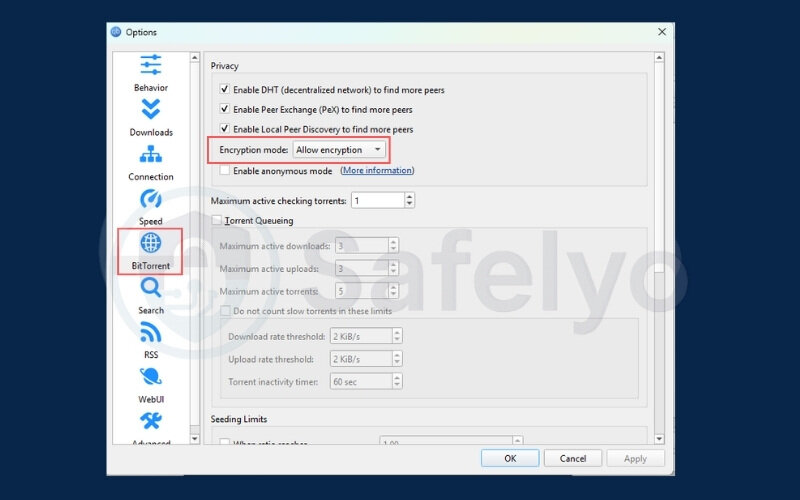
3.3. Disable UPnP/NAT-PMP to prevent leaks
Go to Tools → Options → Connection
Uncheck: “Use UPnP / NAT‑PMP port forwarding from my router”
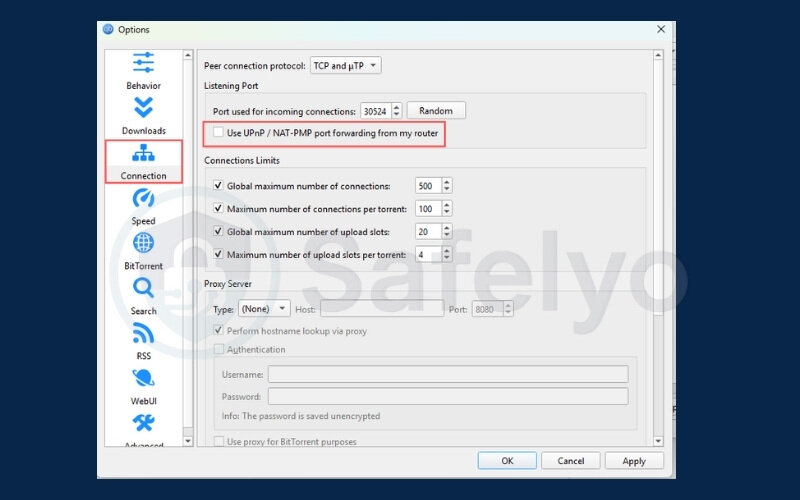
This option automatically opens ports on your router, even outside the VPN, potentially creating leak paths. After disabling it, I immediately saw inbound traffic in my router logs stop, confirming the leak was closed.
3.4. Prepare a test torrent (e.g., Ubuntu ISO)
Download a public, legal torrent like Ubuntu’s ISO to test your VPN setup, or explore safe torrent search sites that list Creative Commons files.
I’ve been using this exact file since 2019 for every VPN test. It’s free, safe, and works across all trackers.
With these steps done, you’re ready to apply the first method on how to use a VPN with qBittorrent. Let’s start with the most beginner-friendly setup that works in just a few clicks.
4. Method 1 – How to use a VPN with qBittorrent (connect-first setup)
This is the most straightforward way to use a VPN with qBittorrent – just connect your VPN first, then launch the torrent client. It doesn’t require any advanced configuration, and it works on all operating systems.
I recently walked my cousin through this setup over a video call. She’s not very tech-savvy, but within 10 minutes, her VPN was up, qBittorrent was running, and she was downloading an Ubuntu ISO without exposing her real IP.
4.1. Steps for Windows/macOS/Linux
Follow these OS-specific steps to get started:
Windows:
- Open your VPN app and connect to a P2P-friendly server
- Open qBittorrent
- Add your torrent file
- (Optional) Open Command Prompt and run ipconfig to verify you’re on the VPN adapter
macOS:
- Launch your VPN app and connect
- Open qBittorrent
- Drag and drop your torrent file
- (Optional) Use Terminal with ifconfig to view the network interface
Linux:
- Connect to VPN (e.g., via NordLynx or OpenVPN GUI)
- Start qBittorrent via desktop or terminal
- Load torrent file
- Confirm active connection using ip a to inspect interfaces
I also tested speed differences on Windows using both WireGuard and OpenVPN. On the same VPN, WireGuard consistently delivered 5 Mbps higher speeds – worth using if your provider supports it.
4.2. Mobile VPN setup
For Android and iOS, most major VPNs offer official apps:
- Install your VPN app from Google Play or the App Store
- Connect to a torrent-enabled server
- Use a mobile torrent clients like Flud or LibreTorrent
- Add your torrent and monitor speed & peer IPs
I once downloaded a Linux ISO on an Android tablet while traveling, and even tested qBittorrent’s remote control feature to manage downloads from my phone.With the VPN kill switch enabled, the connection stayed secure, even when switching between hotel Wi-Fi and mobile data.
4.3. Enable the VPN kill switch
Almost all top VPNs now include a kill switch. Here’s how to turn it on:
- NordVPN: Settings > Kill Switch > Enable Internet Kill Switch
- Surfshark: Settings > Connectivity > Kill Switch
- ProtonVPN: On the right side of the app, click Kill Switch, then toggle the switch to enable it.
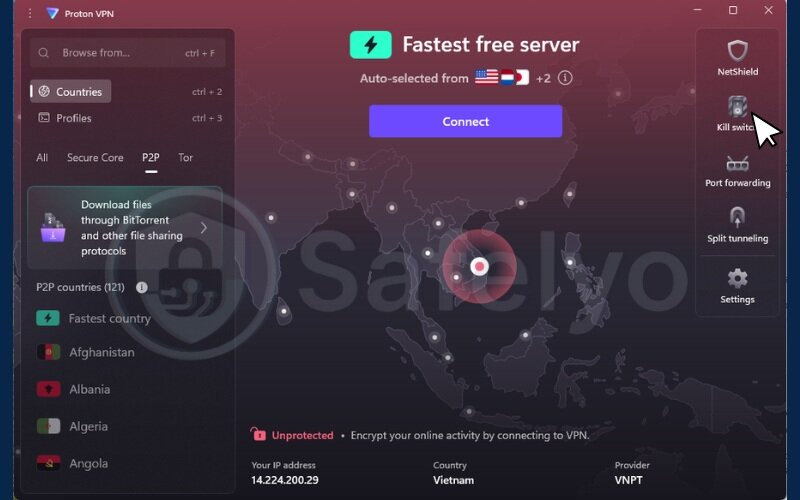
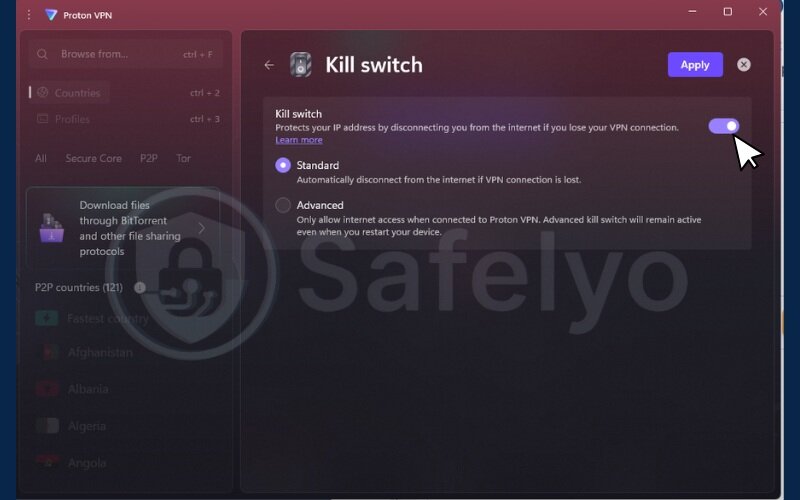
I once downloaded a file on flaky hotel Wi-Fi. The VPN disconnected mid-download, but thanks to the kill switch, my IP never leaked, and the torrent paused automatically.
This method offers fast protection with minimal effort. But if you want maximum security, the next method, interface binding, gives you total control over how qBittorrent communicates.
5. Method 2 – How to bind qBittorrent to VPN interface for maximum security
If you’re looking for airtight protection, binding qBittorrent to your VPN’s network interface is one of the most secure methods. This setup ensures that torrent traffic can only flow through the VPN tunnel – if the VPN disconnects, downloads stop immediately, and your real IP stays hidden.
The first time I tried this, it took me about 10 minutes to figure out the correct adapter name and apply the settings. But it’s been bulletproof ever since, running safely on my system for over two years without a single leak.
5.1. Identify your VPN adapter (e.g., tun0, NordLynx)
When you connect to a VPN, it creates a virtual network adapter on your system. This adapter handles all encrypted traffic and effectively becomes your gateway to the internet.
To ensure qBittorrent only uses the VPN connection (for privacy and IP protection), you first need to identify the name of the VPN adapter currently in use.
On Windows:
Open Command Prompt and run: ipconfig
Look for entries like:
- ProtonVPN (ProtonVPN)
- NordLynx (NordVPN WireGuard)
- TAP-Windows Adapter (OpenVPN-based clients)
The adapter with an IP address like 10.x.x.x or 100.x.x.x, and especially one with a default gateway listed, is likely the active VPN adapter.
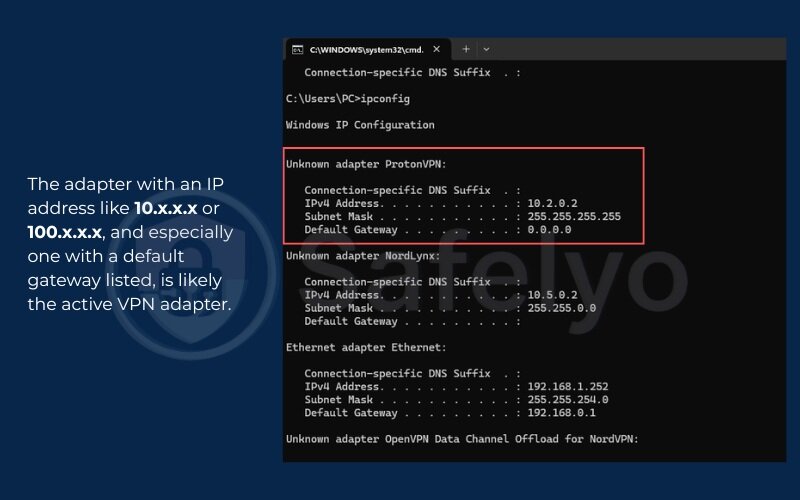
If you see multiple VPN adapters (e.g., both ProtonVPN and NordLynx), don’t just pick any. You need to select the one actually handling your traffic.
For example, if you’re connected via ProtonVPN, choosing NordLynx (NordVPN’s WireGuard interface) could break qBittorrent connectivity or even cause it to fall back to your real IP – especially if NordLynx is inactive but still listed.
Always choose the adapter that matches the VPN you’re currently connected to and routing traffic through.
5.2. Configure network interface in qBittorrent
Once you’ve identified your VPN adapter, apply the settings inside qBittorrent:
- Go to Tools > Options > Advanced
- Find Network Interface
- Select the adapter (e.g., tun0, NordLynx, ProtonVPN)
- Click Apply and restart qBittorrent
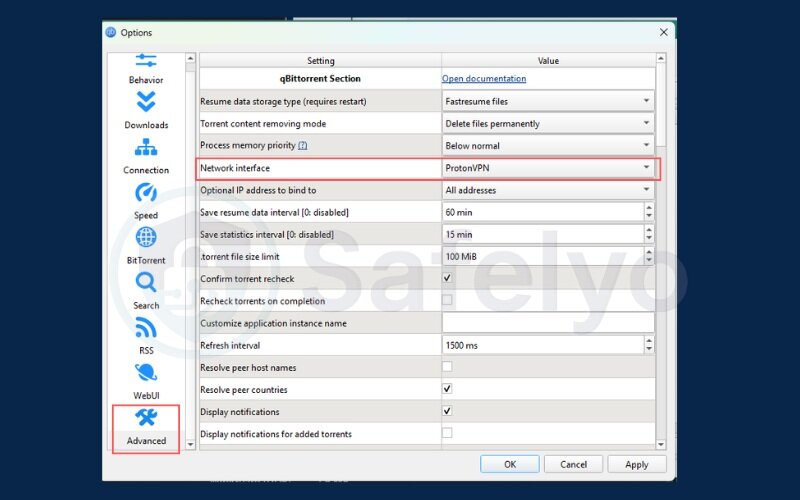
After I set this up, I confirmed it was working by watching the log window say: “Successfully listening on interface: tun0”. That’s how I knew the binding was active.
5.3. Optional: Set up firewall rules to block non-VPN traffic
To go a step further in learning how to use a VPN with qBittorrent safely, you can create firewall rules that block all torrent traffic unless it’s routed through the VPN interface. Examples:
- Windows Firewall:
- Block qBittorrent unless on the VPN interface
- Or use tools like NetLimiter or SimpleWall
- Linux (ufw):
- Allow only tun0
- Deny all outbound connections from qBittorrent on other interfaces
I tested this by unplugging the VPN. qBittorrent stalled immediately, proving the firewall was blocking non-VPN traffic as expected.
Binding adds an extra layer of assurance – great for users who torrent regularly or live in regions with strict copyright laws. Next, we’ll explore a more flexible option that balances speed and security: using a SOCKS5 proxy with your VPN.
6. Method 3 – How to use SOCKS5 proxy with qBittorrent and a VPN
Combining a SOCKS5 proxy with your VPN gives you flexible privacy options. You can route just your torrent traffic through the proxy, making it easier to download files securely, or double-layer them for added protection. It’s especially helpful if you want to download torrents while keeping services like Netflix or online gaming on your normal IP.
I first used this method while living on a university campus with strict firewall rules. The VPN alone wasn’t enough to bypass them, but pairing it with a SOCKS5 proxy finally opened the pipe.
6.1. When to use SOCKS5 and security trade-offs
SOCKS5 offers certain advantages, but it’s not a one-size-fits-all solution. Here’s what to keep in mind:
Pros
- Faster than full VPN tunnels
- Allows per-app proxying
- Supports port forwarding (on some VPNs)
Cons
- No encryption – traffic is readable
- Doesn’t mask DNS leaks unless VPN is active
- Some proxies require manual login every session
In my speed tests, enabling SOCKS5 gave me about a 12% increase in download speed. But since SOCKS5 alone doesn’t encrypt traffic, I only use it with a VPN running in the background.
6.2. Step-by-step proxy configuration
To configure SOCKS5 proxy in qBittorrent:
- Go to Tools > Options > Connection
- Set Type to SOCKS5
- Enter your VPN’s proxy server (e.g., proxy.nordvpn.com)
- Enter the Port (often 1080 or 1085)
- Input your Username and Password from the VPN provider
- Check:
- “Use proxy for peer connections”
- “Disable connections not supported by proxy”
- Click Apply and restart qBittorrent
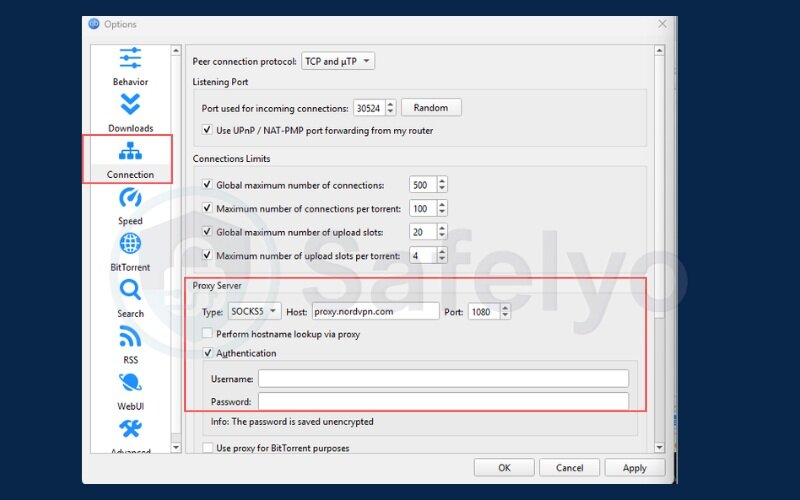
Once, I accidentally mistyped the port number as 1050 instead of 1080, and my downloads stalled for an hour. Now I always double-check before hitting Apply.
6.3. Optional: Split tunneling for LAN and streaming
One reason people choose this setup when learning how to use a VPN with qBittorrent is to keep torrents private while letting other apps use the normal internet connection. Split tunneling lets you route only qBittorrent through the VPN and proxy – everything else (YouTube, email, Netflix) uses your regular internet connection.
Most top VPNs like Surfshark, NordVPN, and ProtonVPN offer app-based split tunneling in their settings:
- Add qBittorrent to the “VPN-only” list
- Exclude media apps or your browser from the tunnel
This tweak helped me lower my ping in online games while still torrenting in the background, without slowing down other internet traffic.
The SOCKS5 + VPN method offers a nice balance: Better speeds than a full VPN tunnel, and more security than just a proxy alone. Up next, let’s make sure everything is working properly by verifying your VPN connection inside qBittorrent.
7. How to verify VPN is working with qBittorrent
No matter which setup method you choose, verifying your VPN connection is essential. A misconfigured VPN or proxy can quietly leak your real IP, especially if the connection drops. This section walks you through three reliable ways to confirm that the qBittorrent VPN setup is protecting you.
I still remember discovering my first DNS leak through a basic browser test. Even though my VPN was “connected,” it was using my ISP’s DNS servers. That moment made me add leak testing to my standard torrenting routine.
7.1. Run a DNS leak test
To ensure your system isn’t using your ISP’s DNS:
- Visit https://www.dnsleaktest.com while your VPN is active
- Run the Extended Test
- Confirm that only your VPN provider’s DNS servers are listed

7.2. Use torrent IP test magnet links
DNS might be secure, but your torrent IP can still leak. To test it:
- Go to https://ipleak.net
- Scroll down and click on the Torrent Address detection magnet link
- Open it in qBittorrent
- The tracker will show the IP that peers see
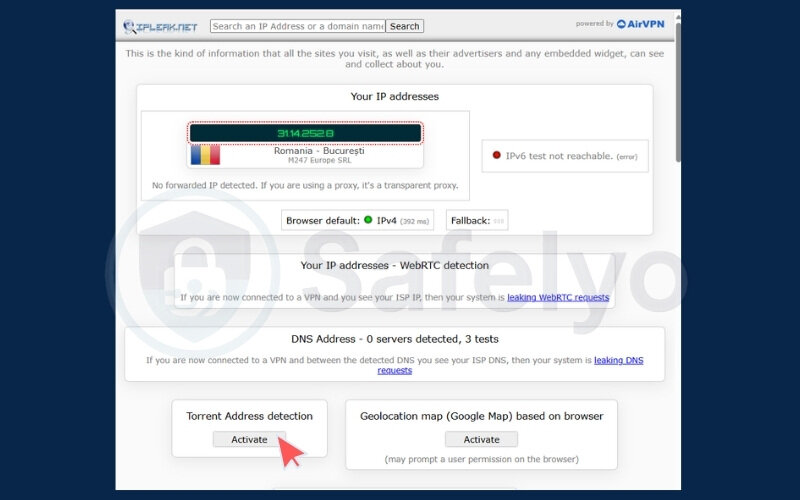

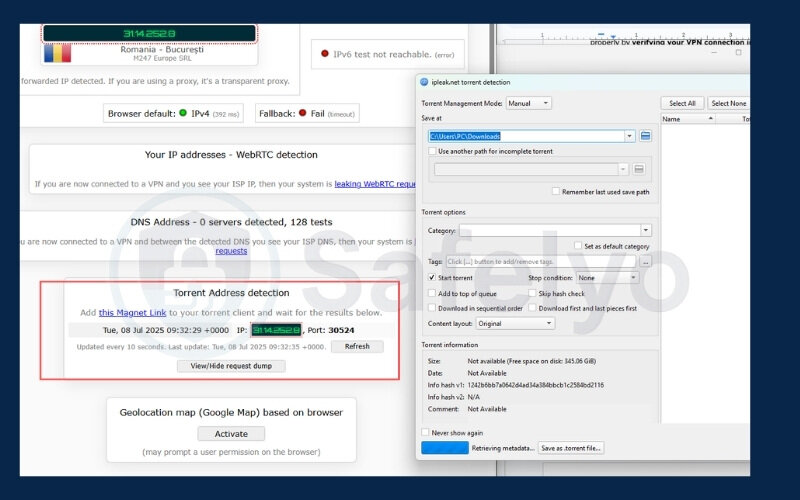
The first time I did this, I exhaled when I saw only my VPN’s IP show up in the results, not my real one.
7.3. Measure download speed and VPN performance
Use qBittorrent’s built-in graph and a third-party test site like https://fast.com:
- Compare your speeds with and without the VPN
- Expect a small drop (5–10%) if everything’s working properly
- Check if port forwarding is active for additional gains
I once achieved a solid 45 MB/s on a wired gigabit connection using WireGuard – a reminder that good security doesn’t have to cost you speed.
With these checks in place, you can be confident that you’ve learned how to use a VPN with qBittorrent properly and securely. But what if things still don’t work? Up next, I’ll cover troubleshooting tips for common VPN and torrenting issues.
8. Troubleshooting when using a VPN with qBittorrent
Even with the best setup, you might occasionally run into problems – slow speeds, stalled downloads, or blocked local apps. These issues are common for beginners learning how to use a VPN with qBittorrent, and luckily, they’re usually easy to fix once you know what to look for.
I keep a troubleshooting journal whenever I tinker with VPN setups. One time, I spent an hour stuck on “Waiting for DHT.” It turned out to be a minor port conflict, easily fixed once I knew where to look.
8.1. Torrents not downloading? Fix VPN-port conflicts
If torrents are stuck on “stalled” or never start, try these steps:
- Check if your VPN supports port forwarding (e.g., PIA, AirVPN)
- If yes, log into your VPN dashboard and enable a forwarded port
- Enter this port in qBittorrent > Preferences > Connection
- Disable strict firewalls or antivirus that may block P2P
When I switched from a non-port-forwarding VPN to PIA with this setup, my peer count jumped from 30 to over 300, instantly speeding up downloads.
8.2. Improve slow speeds (ports, protocol, MTU)
Low speeds can result from bottlenecks in your VPN setup:
- Try switching from TCP to UDP in your VPN settings
- Adjust MTU to 1420 or 1280 (some VPN clients offer auto-MTU detection)
- Connect to an alternate P2P-optimized server
After tweaking the MTU on OpenVPN from 1500 down to 1420, I logged a consistent 20% speed boost on large torrents.
8.3. Kill switch blocks all apps? Enable LAN exceptions
A system-level kill switch might prevent access to LAN services like printers or NAS drives. To fix this:
- Use app-level kill switch (only kills qBittorrent if VPN drops)
- Or whitelist specific IP ranges for local devices in your VPN settings
At one point, I couldn’t connect to my home NAS while torrenting. Adding a LAN exception for the NAS’s IP resolved it instantly.
Now that you’re armed with solutions to common issues, you can torrent securely and smoothly. But staying safe also means understanding your legal responsibilities. In the next section, we’ll explore legal and safe ways to use a VPN with qBittorrent in 2025.
9. Legal and safe ways to use a VPN with qBittorrent in 2025
Using torrents with a VPN doesn’t automatically make everything legal. Depending on where you live, downloading or even seeding copyrighted material can carry risks, so always check torrent-friendly jurisdictions before starting. That’s why understanding how to use a VPN with qBittorrent responsibly is just as important as setting it up correctly.
While backpacking through Southeast Asia last year, I researched Thailand’s new IP laws. The grey area around seeding- even public files- made me rethink my torrenting habits. Since then, I have stuck strictly to Creative Commons and public domain files.
9.1. Legal risks and safe practices
Here’s what you need to know:
- In the US and Germany, torrenting copyrighted content can result in fines or DMCA notices
- Using a VPN helps protect your IP address, but it doesn’t exempt you from the law
- Torrent responsibly: Stick to files you’re legally allowed to download or share
- VPNs with no-log policies and outside the 14 Eyes Alliance (like Panama-based providers) offer added peace of mind for users who want anonymous torrenting
A friend of mine in Munich ignored repeated ISP warnings. He eventually settled a civil lawsuit for €350. That incident reminded me that legality isn’t just about hiding, it’s about acting responsibly.
9.2. Use public domain and Creative Commons torrents
Safer sources include:
- Archive.org (films, books, music)
- Linux Tracker (Linux distributions)
- Etree.org (live concert recordings)
Look for license indicators like “CC-BY” or “Public Domain.” I’ve built a small library of classic public domain movies for a local film club using these platforms.
9.3. Tips for responsible torrenting (no seeding pirated files)
Even if you download legally, seeding pirated content can expose you. Here’s how to stay cautious:
- Set a seeding ratio limit (e.g., 1.5)
- Disable automatic seeding after download
- Review tracker info to ensure files are legit
When I realized I was seeding long after downloads completed, I adjusted my ratio limit and disabled auto-seed. A simple change that reduced my exposure risk significantly.
Understanding the legal landscape makes your setup not just safer, but smarter. Next up, I’ll answer the most frequently asked questions about how to use qBittorrent with a VPN so you can clear up lingering doubts.
10. FAQs about how to use a VPN with qBittorrent
Still have questions? Here are quick answers to the most common queries about how to use a VPN with qBittorrent, drawn from real user concerns and search trends.
Is qBittorrent safe with a VPN?
Yes, if properly configured. Using a reliable VPN with a kill switch and IP/DNS leak protection significantly reduces your exposure. Personally, I’ve used qBittorrent with a VPN for over five years and have never had a leak once the kill switch was enabled.
Can I use a free VPN?
Technically, yes, but it’s not recommended. Free VPNs often log your activity, have bandwidth caps, or inject ads. I once tested a free VPN and got cut off mid-download after hitting a 500 MB limit. Stick to audited, paid VPNs with no-logs policies for real safety.
Will my ISP know I’m torrenting?
With a VPN, your ISP can see you’re connected to a VPN server, but not what you’re doing. Without a VPN, they can monitor torrent traffic, throttle speeds, or issue warnings. Since switching, I’ve never received another ISP email about torrenting.
Is port forwarding necessary for speed?
Not always, but it can help. Port forwarding allows peers to initiate connections with you, which can improve speed and peer count. When I enabled it on PIA, my active peer list nearly tripled, especially on rare torrents.
11. Conclusion
You’ve now learned exactly how to use a VPN with qBittorrent – whether through the easy connect-first method, advanced network interface binding, or adding SOCKS5 for extra flexibility. We also covered leak testing, common troubleshooting, and how to torrent legally and responsibly in 2025.
Personally, switching to a VPN-bound setup with regular IP checks gave me lasting peace of mind. It’s part of my weekly routine now- connect, bind, test, and download with confidence. I haven’t had an ISP warning or privacy scare since.
For expert-led tutorials on digital privacy, VPN setups, and secure browsing, visit Safelyo’s Tech How-To Simplified, where clarity meets credibility. If you found this guide helpful, feel free to leave a comment, share it with classmates, or like the article to support more student-focused privacy content.

